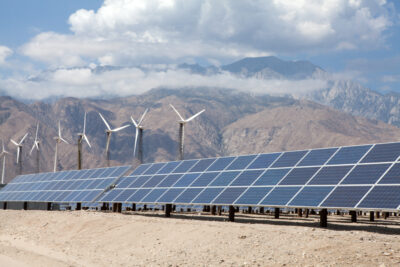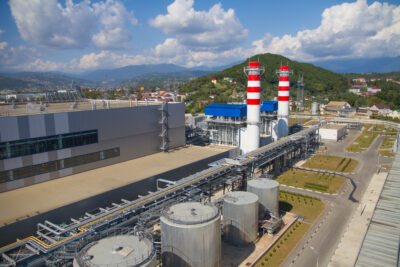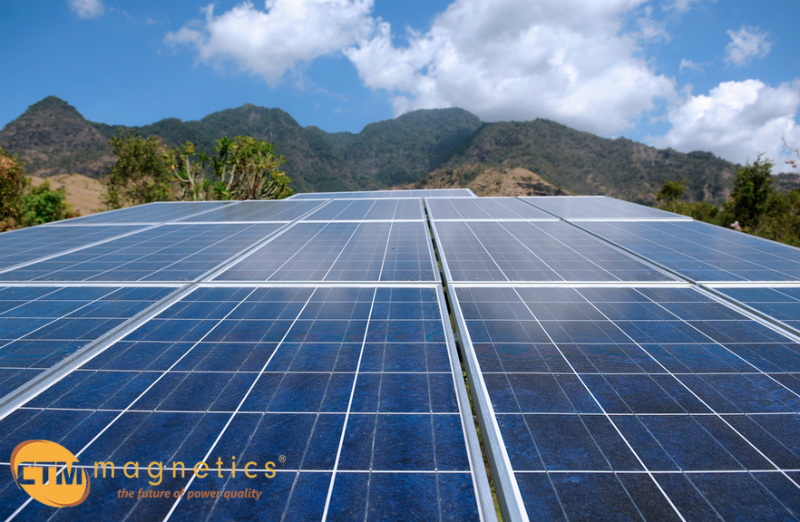Basic Solar Energy Storage
Solar energy in the most basic terms is energy received from the sun. Passive solar energy is heat that does not require conversion for use. This passive energy is used for space and water heating. Passive design allows for cooling by limiting that amount of heat gained from the Sun. The most common form of active solar energy uses solar photovoltaics to convert the Sun’s energy into electricity that can be used to power residential, commercial, and industrial needs. 
For small-scale use, the light from the Sun hits photovoltaic cells in a solar panel, converting it into DC electrical current. A solar inverter is often used to convert this current from DC to AC. For large scale use, many solar panels can be connected together to form a solar array. A very large grouping of solar arrays is sometimes referred to as a solar farm.
Some large power plants utilize lenses or mirrors and tracking systems to concentrate sunlight on a small area and collect the energy as heat. The heat is then used to power turbines or motors that drive a generator to produce electricity.
The process of collecting the Sun’s energy during daylight hours has been used for years in various methods. However, since the Sun does not always shine, in order to match supply and demand over a 24 hour period, excess solar energy must be stored during the day to provide power overnight. Energy storage for intermittent solar energy sources is critical for the long-term viability of grid-connected solar power.
Thermal solar energy storage
Thermal energy can be stored in several ways. Passive storage methods simply collect heat from the Sun during daylight hours and release the heat once their surroundings cool. Water, concrete and many other materials are good at storing heat. The heat accumulates during the day and can then be released during the night.
Ice storage is another method used for storing thermal energy. The ice is created through solar power generated during the day and then the ice can be used for cooling during the night. In the reverse, ice-based air conditioning uses energy to create ice during the night hours (when energy demand and cost is low). The ice is then used during the daytime for cooling, reallocating demand on the power grid from a time of high demand to a time of low demand.
Both of these types of solar energy storage are utilized in different areas, but are not necessarily created for large power plants and only address HVAC concerns. To produce quality power, the need for electrical solar energy storage in a clean, efficient manner is one that must be addressed for the future.
Electrical solar energy storage
Electrical solar energy storage can be understood by looking at landscape lighting. An individual solar landscaping light uses a photovoltaic cell on the top to gather the Sun’s energy during the day. The fixture also uses a double or triple A rechargeable battery. This is a perfect example of a small-scale battery energy storage system.
The energy from the Sun is converted into electricity that charges the battery in the fixture. A light sensor is normally used to keep the bulb from turning on during daylight. When the sensor no longer detects light, the energy stored in the battery provides power to light the bulb.
For individual household use, the same principle is used for solar energy storage. A larger battery system is used to hold the energy for use during the night or on cloudy days. Battery energy storage can be scaled up for commercial, industrial, and utility-scale uses. While better batteries and other storage methods with higher energy densities are being investigated, even in utility-scale applications, lithium-ion battery energy storage is the most developed and easiest to deploy method.
As an alternative to batteries, supercapacitors are being investigated as an alternative electrical energy storage system because of their potential for higher energy densities. However, supercapacitors are currently cost prohibitive for widespread use.
Other methods
Molten salt thermal energy storage systems are seeing increased use. In these systems, concentrating solar power (CSP) technology is used to reflect a large amount of sunlight into a concentrated area. This concentrated solar energy is used to heat sodium, potassium, and calcium nitrates into a molten salt mixture. The molten salt is pumped into an insulated hot storage tank that can keep the mixture hot for up to a week. When electricity is required, heat from the molten salt is used to boil water, producing superheated steam. A steam turbine / electric generator combination then converts the steam’s thermal energy into useful electricity. The use of molten salt as a storage medium not only adds energy storage capabilities, it also has been proven to be more efficient than photovoltaic (PV) solar arrays.
However, due to overhead costs, this system is currently only economically feasible in large, utility-scale installations. Molten salt solar thermal energy power plants were demonstrated as viable with two installations in the Mojave Desert, Califonia, USA. Since those pilot projects, a 20 MW commercial power plant using identical technology has been brought online in Seville, Spain. This plant supplies power to 27,500 homes, and is the first solar plant to achieve continuous, 24 hour power production.
Currently a power plant in Spain is using a combination of sodium and potassium nitrates as a storage medium. In this solar thermal power system, during the daylight hours, solar energy is used to heat oil-filled tubes. The heated oil is then used to boil water and produce steam. The steam powers a turbine that generates electricity. Extra heat collected during the day is sent to vats filled with molten salts. When the Sun goes down, the heated salts are used to boil the water to produce steam. A larger. 280 MW plant using similar technology is up and running near Gila Bend, Arizona, USA. This plant was designed to provide six hours worth of energy storage.
[caption id="attachment_5108" align="alignleft" width="400"] thermal power plant[/caption]
thermal power plant[/caption]
Other energy storage methods are currently being studied and used in limited commercial capacities. Where available, excess solar energy is being used to pump water from the bottom of a dam up to the top of the reservoir (pumped-storage hydroelectricity). This stored potential energy is later recaptured in a hydroelectric turbine-generator. This form of energy storage currently has the largest available energy storage capacity for the grid.
Compressed air energy storage stores excess energy by compressing air into a cave system or other large vessel. When energy is required, pressure is released and converted into electricity with a turbine-generator system. Fuel cells are also being used as a solar energy storage method. As more research is done in the use of solar energy, better storage methods will be developed. By reducing the costs of generating and storing solar energy, the technology will become more widely available for use by everyone.
 " alt="">
" alt="">